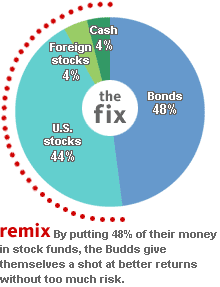|
Crafting the perfect retirement plan
Eric and Juanita Budd were nervous investors, but now they want to retire in 15 years.
NEW YORK (MONEY Magazine) - For much of Eric and Juanita Budd's marriage, savings came second. Juanita, now 45, stayed at home with daughters Alexis and Alera, while Eric's consulting income paid the bills. By 1999, with Juanita working as an executive at a local nonprofit and Eric, now 53, teaching special education full time at a college in Austin, their income hit six figures. They bought a small fixer-upper on Lake Travis and started socking away money, but they are nervous investors.
Stocks scare them. "I'd put the money under a mattress if I could," says Juanita. Where are they now?
They're practically stuffing the mattress now. About two-thirds of the Budds' $96,000 in retirement savings is in cash and bonds, including $17,000 in Hertz corporate bonds -- a buy made on a broker's tip. The couple have another $18,000 in CDs earning less than 1 percent interest. On the minus side of the ledger, they have $20,000 in credit-card debt. Add it all up, says Louis Kokernak, a certified financial planner in Austin, and the Budds are actually more vulnerable to inflation and the vagaries of the financial markets than they would be if they owned more stocks. What they should do
The Budds are realistic in stating that retirement is another 15 years off. They can retire comfortably, says Kokernak, if they save $14,000 a year, remix their portfolio and follow through on the plan to sell their Austin home and move to the lake. Including their pensions and Social Security, the Budds should end up with a retirement income of $82,000. While the Budds' main strategy should be to own more stocks overall, Kokernak suggests they first load up their retirement accounts with fixed income. Since bonds generate income that's taxed at a higher rate than stock gains, it makes sense to keep bonds in retirement accounts, which qualify for serious tax breaks. Eric should reallocate the $10,000 in his 403(b) to his TIAA-CREF fixed-income option. Juanita holds $39,000 in 11 mutual funds in her 403(b). About $26,000 of that is already in a Vanguard fund that maintains a 60-40 split between stocks and bonds, so Kokernak recommends she consolidate all of her money there to help push up the couple's stock allocation. Because Juanita's employer doesn't match her 403(b) contributions, the planner also suggests that for now she divert her $500 monthly investment to paying off credit cards. If she adds another $500 a month, the couple will be debt-free in less than two years. For the $23,300 in their taxable account, Kokernak recommends trading the Hertz notes for a broad stock fund like the ultra-low-cost Fidelity Spartan 500 Index (FSMKX), a MONEY 65 fund. And they should replace their low-yielding CDs with a bond index exchange-traded fund like the MONEY 65's iShares Lehman 1-3 Year Treasury (SHY). That would bring the couple's mix to about half stocks, half bonds, which is still conservative. Older daughter Alexis will rely on scholarships and loans when she starts college next fall, with the Budds contributing no more than $5,000. For 14- year-old Alera, the Budds should try to put $2,000 a year into an education IRA -- but not at the expense of retiring debt. |
| |||||||||||||||||||||||||


